Irrigator for oral cavity "2 in 1" Kitfort KT-2904
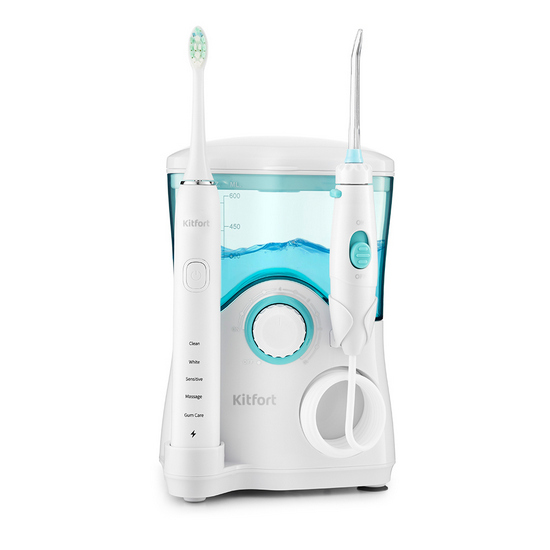
Technical characteristics of the Kitfort KT-2904 irrigator
- Voltage: 100-240 V, 50/60 Hz
- Power: 18W
- Tank capacity: 600ml
- Number of irrigator operating modes: 10
- Electric shock protection class: II
- Jet pulsation frequency: 1250-1700 imp / min
- Water pressure: from 2 to 8.5 bar (depending on the selected mode)
- Toothbrush power: 1.5W
- Toothbrush battery: Li-ion, 3.7 V, 750 mAh
- Toothbrush type: sonic
- Toothbrush frequency: 31,000 dpm
- Toothbrush timer brush: yes
- Toothbrush charging indication: yes
- Number of operating modes of the toothbrush: 5
- Noise level: 75 dB
- Device size: 140 x 130 x 208mm
- Package size: 184 x 134 x 225mm
- Net weight: 1.1kg
- Gross weight: 1.3kg
An irrigator is an oral care device. It is very easy to use: pour water (or a special solution for rinsing your teeth) into the tank, select the mode that suits you and start cleaning.
After eating, food debris gets stuck between the teeth, clogged in the pockets of the gums. In such cases, dental floss or flosser can come to the rescue. But for cleaning your teeth with a floss, you need to ensure that your hands are clean, and the opportunity to wash them is not always available. Otherwise, the likelihood of pathogenic bacteria and viruses entering the oral cavity increases. Also, flossing can mechanically damage the gums.
An irrigator can partially replace dental floss or flosser. A thin and powerful jet of water washes away food debris and plaque from the interdental space and periodontal pockets. The jet of water not only cleans hard-to-reach places, but also thoroughly massages the gums, which is a good prevention of gum disease.
An irrigator will be useful for caries prevention if fluoridated or calcined solutions are used to prevent plaque from smoking, coffee or strong tea. In case of gum diseases, the use of the device with medicinal and antibacterial solutions will increase the effectiveness of treatment and sanitation.
But with all the advantages of an irrigator, there are situations when it cannot be used. These are diseases of the teeth, gums and oral cavity in the acute phase, acute cardiovascular diseases (consultation of the attending physician is required), recent operations in the oral cavity, increased sensitivity of the teeth and bleeding gums. For preschoolers, use a gentle jet setting.
The Kitfort KT-2904 model is a stationary irrigator with a sonic toothbrush designed for all family members at home.
The sonic toothbrush has 5 modes of operation.
The irrigator has a spacious 600 ml water tank. This amount is enough to completely treat all hard-to-reach areas in the mouth.
On the body of the device there is a jet pressure regulator and an on / off switch. The jet pressure can be adjusted smoothly from 1 to 10. If you have not used the irrigator before, it is recommended to start using it by setting 2 or 3 modes, as unprepared and sensitive gums may begin to bleed due to the strong and sharp flow of water.
The irrigator comes with 7 nozzles: 3 classic jet nozzles, a nozzle for removing tartar and plaque from under the gum line, a nozzle for orthodontic structures, a nozzle with a brush for removing plaque, and a nozzle for cleaning the tongue. The toothbrush also comes with an extra brush head.A special container is provided for storing the nozzles, which is also the lid of the water tank. This is very convenient, because if the attachments are always in one place, they will not be lost.
You can put the irrigator itself in the bag that comes with the irrigator.
Rubber feet with suction cups keep the irrigator firmly in place on the sink or bathroom counter.
The accessory holder has a swivel mechanism that rotates the installed accessory 360 °. Also on the holder there is a Start / Stop switch, with which you can stop the water supply at any time without turning off the irrigator itself.
The device turns off automatically after 3 minutes of use.
For preventive purposes, an irrigator is needed by every adult. The irrigator, complete with a sonic toothbrush, is a convenient 2-in-1 device for complete oral care.
Before using the irrigator and sonic toothbrush, it is necessary to consult a doctor, as it may be contraindicated to use these devices in the event of diseases of the teeth and gums.
Kitfort KT-2904 irrigator complete set
- Irrigator:
- Building: - 1 pg.
- Water tank - 1 pc.
- Storage container for attachments (reservoir lid) - 1 pc.
- Toothbrush - 1 pc.
- Additional head for a toothbrush - 1 pc.
- Classic jet nozzle - 3 pcs.
- Tartar removal attachment - 1 pc.
- Orthodontic attachment - 1 pc.
- Nozzle with a brush for removing plaque - 1 pc.
- Tongue brush - 1 pc.
- Bag - 1 pc.
- Operation manual - 1 pc.
- Warranty card - 1 pc.
- Collectible magnet - 1 pc. * Optional
Irrigator device Kitfort KT-2904

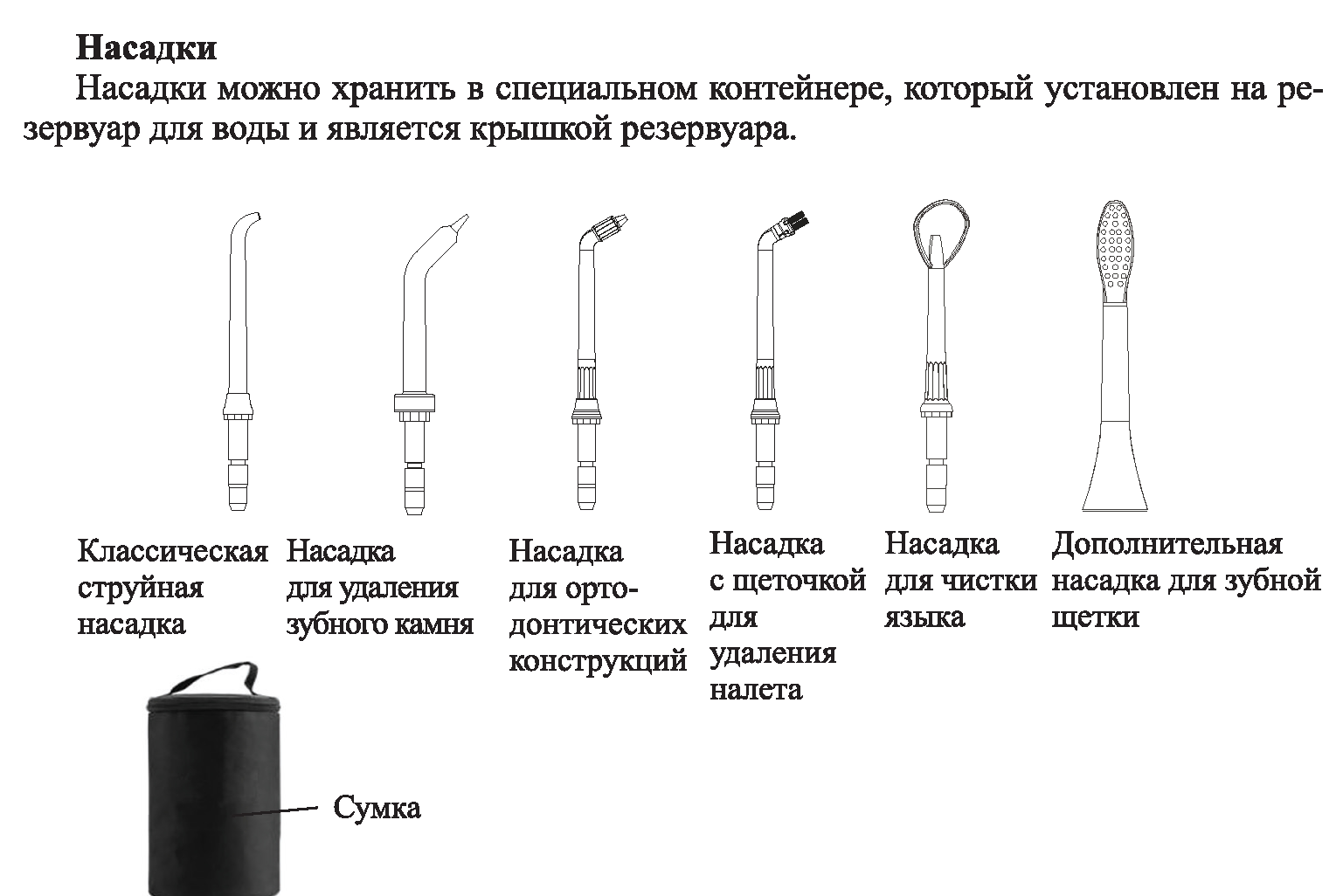
Switch "On / Off"
If you want to stop the water flow while the irrigator is running, turn the switch to the “Off” position and the water will stop coming out of the nozzle.
Further in the text of the instruction, the position "Оn" of the switch will be called "Start", and the position "Off" - "Stop".
Regulator
OFF - disabled, hereinafter referred to as "Off".
ON - enabled, hereinafter referred to as "On".
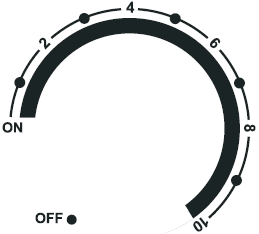
The regulator smoothly regulates the water pressure, you can set modes from 1 to 10.
Sonic toothbrush
A sonic brush, in contrast to an ultrasonic one, does not create additional wave beating, and the vibration speed is an order of magnitude lower. The sonic brush effectively removes plaque. The vibrating motion of the brush helps to gently remove food debris while also massaging the gums to improve blood circulation. When the bristles move, the toothpaste mixes with saliva and water. This creates an oxygen-rich foam that has an antibacterial effect and penetrates hard-to-reach areas. Tartar and plaque are carefully cleaned without destroying teeth with damaged enamel. A sonic toothbrush does not injure the gums, which is especially important in case of gum disease.
Attention! It is not recommended to use sonic brushes for children under 6 years old, fragile enamel is not ready for such a cleaning speed and may begin to deteriorate.
A sonic brush is recommended:
- if there is deep interdental plaque;
- there are growths of stones on the back of the tooth;
- for daily use in the absence of stomatitis and increased tooth mobility;
- in the presence of crowns and braces.
The sonic toothbrush of the KT-2904 irrigator has 5 operating modes, a timer for 2 minutes and inductive (wireless) charging. Inductive charging works like a transformer - based on magnetic induction. Coils of a certain number of turns of wire are built into the charging (on the charging platform) and the brush body. If a current is passed through one coil and another is placed next to it, then a current will also arise in it. He also charges the battery of the toothbrush.
Toothbrush operating modes

Preparing for work and using a toothbrush
Charging
Make sure the toothbrush is turned off before charging.Place your toothbrush on the charging pad on the irrigator body and make sure the appliance is plugged in. While charging, the charging indicator on the brush starts flashing. Charging is complete when the indicator on the brush stops flashing and turns on continuously. The charging indicator may take 6-10 minutes to start working if you haven't used the brush for a long time. If the toothbrush has not been used for more than 6 months, charge it for at least 12 hours to achieve a full charge.
If you brush your teeth twice a day (morning and evening) for two minutes, a full charge of the toothbrush will last 21 days of use. It is recommended to replace the toothbrush head after three months.
To prolong battery life, do not fully discharge the battery more than once a year. Fully charge the brush battery before first use.
Using

Dentists recommend replacing the toothbrush head every 3 months for the best brushing results. Also replace the brush head when the bristles are frayed.
Preparing for work and using the irrigator
Before using for the first time, fill the reservoir with water, place the jet nozzle in the nozzle holder and run one cycle with water, pointing the nozzle into the sink. Wash the attachments with soap and water.
How to add water
Remove the accessory storage container from the reservoir and set it aside. Pull up the water tank, remove it from the irrigator body and fill the tank with water, not exceeding 600 ml.
Use boiled water or a mouthwash solution. The temperature of the water or solution must not exceed 45 ° C.
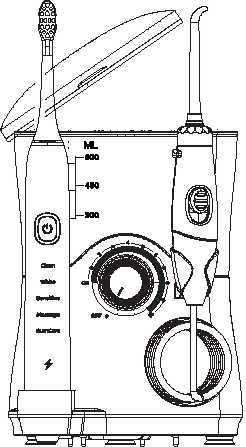
Installing the nozzle
The attachment is an individual accessory for each family member.
Insert the accessory into the hole in the accessory holder until you hear a click. To remove the accessory, press the accessory release button and pull the accessory up.
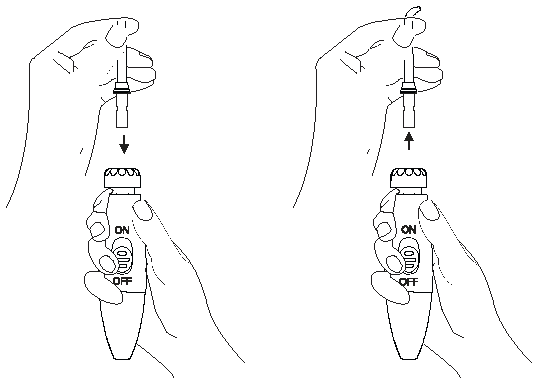
Using
- Place the irrigator on a sink or bathroom counter on a flat, horizontal surface. Rubber feet with suction cups keep the irrigator firmly in place on the sink or bathroom counter.
- Before irrigating the oral cavity, brush your teeth (see chapter "Preparing for work and using a toothbrush"),
- Pour water or a special solution into the tank, install the desired nozzle in the holder.
- Turn the swivel mechanism of the holder with the nozzle to adjust the direction of the water flow.
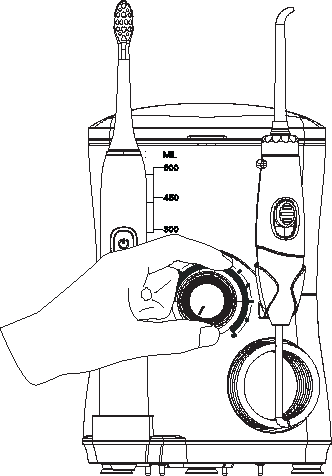
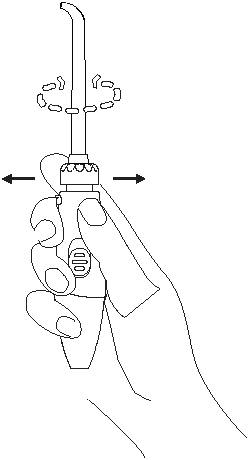
- Before turning on the irrigator, tilt the holder at a 45 ° angle and point the nozzle into your mouth. With one hand, grip the holder with your thumb on the Start / Stop switch and with the other hand turn the regulator on the irrigator body.
Note. If you have not used an irrigator before, it is recommended to start using it by setting 2 or 3 modes, as unprepared and sensitive gums can begin to bleed due to the strong and sharp flow of water.
- Turn the regulator on the body to the "On" position and then clockwise to the mode you need. Lean over the sink, open your mouth slightly, set the switch on the holder to the "Start" position. The water from your mouth should drain into the sink. Proceed in the same sequence as in the figure, namely, move from the chewing teeth to the front teeth, guide the nozzle along the gum contour, lingering in the interdental spaces. To reduce splashing, turn the appliance on and off using the switch on the holder only when the nozzle is in your mouth.
Note. Handle the hose carefully, do not stretch it in a straight line. Do not pull or jerk the hose strongly to avoid rupture.
- When the water in the tank runs out, set the switch on the holder to the “Stop” position, and then turn the regulator on the body to the “Off” position.
- Remove the reservoir by pulling it up. Turn the reservoir over and drain the remaining water.If you did not use water, but a special rinse solution, be sure to rinse the irrigator after it. To do this, pour water into the tank, turn on the irrigator, directing the holder with the nozzle down into the sink. Note. If the irrigator is not turned off, the device will turn off automatically after 3 minutes.
It is better to remove the water tank from the housing after each use so that the remaining water evaporates. If the reservoir is not removed and the irrigator is not used for several days, the internal parts can "suffocate" and give an unpleasant odor during subsequent use.
Description of attachments
Classic jet nozzle
With this attachment, you can clean hard-to-reach places in your mouth. Remnants of food that are deeply "clogged" in the dental or intergingival spaces P are easily washed out with a stream of water or a special solution. C
Scaler tip
This tip has a soft rubber tip to prevent damage to sensitive gums. The narrow tip opening creates a fine jet that removes plaque and calculus from under the gum line.
Tartar is a fully or partially mineralized soft microbial plaque that has not been removed by brushing your teeth. In the oral cavity, there is a constant multiplication of microflora (especially after eating), which leads to an increase in the mass of soft microbial plaque. If the plaque is not cleaned off in time, then the process of gradual hardening of the soft plaque begins immediately. This is due to its impregnation with mineral salts contained in saliva.
Orthodontic attachment
The orthodontic attachment is specially designed for people undergoing orthodontic treatment. This nozzle allows you to simultaneously clean and rinse food debris from hard-to-reach areas of the teeth and around braces.
Removal brush attachment
Plaque is a group of bacteria that adhere to the surface of teeth but have not yet mineralized. The soft nap tip of the brush head is very effective in preventing plaque. The brush head cleans areas that are difficult to reach with braces and other dental restorations.
Tongue brush
Cleaning the tongue is a mandatory procedure that every person must do every day. After eating, only 10% of bacteria remain on the teeth and 90% on the tongue. Uncontrolled growth of bacteria on the oral mucosa, including the tongue, can lead to diseases such as stomatitis, glossitis, gingivitis, caries, etc. After you have brushed your teeth with a toothpaste brush and treated the entire oral cavity with an irrigator, go to language.
Procedure for clearing the language:
- Place the tongue brush in the holder.
- Start at the root of your tongue, gradually moving towards the tip. It is enough to run the tongue over the tongue several times.
- Rinse your mouth thoroughly after the procedure.
Extra toothbrush head
Before irrigation, you should brush your teeth with a toothbrush. For details on using the sonic brush, see the chapter “Getting Started and Using the Toothbrush”.
Usage tips
If you are using the irrigator for the first time, set to mode 2 or 3, otherwise the sensitive gums could be injured by the sudden flow of water. Over time, the gums will get used to the new sensations, and you can try to set the modes 4-10.
At the first time of use, slight bleeding of the gums is possible. If you experience severe bleeding from your gums after two weeks of using an irrigator, talk to your doctor.
It is better to open the lid of the reservoir and the container for storing the accessories after each use so that the remaining water evaporates. If the lid is left unopened and the irrigator is not used for several days, internal parts may suffocate and produce an unpleasant odor with subsequent use.
Handle the hose carefully, do not stretch it in a straight line.Do not pull or jerk the hose strongly to avoid rupture.
In order for the container lid to close, the nozzles inside must be laid correctly: the tips of the nozzles should look alternately in one direction or the other, and the inclined parts of the nozzles are directed parallel to the lid.
The recommended temperature of the water or solution should not be higher than 45 ° C, focus on your feelings, over time you will understand what temperature water is most comfortable to use.
If you use special mouthwash instead of boiled water, then over time this can lead to the formation of sediment in the tank and on the internal surfaces. To avoid this, rinse the device immediately after using such solutions.
Cleaning, maintenance, care and storage of the irrigator
Unplug the appliance before cleaning.
Wipe the body of the device with a dry and then with a damp cloth.
Wash attachments periodically with soap and water. Change tips as they wear out.
If the device has not been used for a long time, wash it. To do this, pour water into the reservoir, turn on the irrigator, directing the nozzle into the sink.
If you use special mouthwash instead of boiled water, then over time this can lead to the formation of sediment in the tank and on the internal surfaces. To avoid this, rinse the device immediately after using such solutions.
How to get rid of limescale
After some time, limescale and other deposits begin to accumulate inside the irrigator. It depends on the hardness of the water. Plaque builds up both in the water tank and on internal surfaces. This makes the motor difficult to operate and reduces the service life of the device. Limescale is also a beneficial breeding ground for pathogenic bacteria and organisms. The irrigator cleaner will help remove plaque from all surfaces and hidden parts of the device. Follow the instructions on such a product.
This will help the device to work longer without breakdowns.
But you can use citric acid at the rate of 3 g per 100 ml of water. Pour 200 ml of water with citric acid dissolved in it into the reservoir of the irrigator. Turn on the irrigator for a while, then leave it for 20-25 minutes. Then turn on the irrigator and run the remaining liquid in the reservoir. After that, pour clean water into the tank twice and rinse out the remaining citric acid, directing the holder with the nozzle into the sink.
To unclog the reservoir valve, turn the reservoir over and push the valve downward with a sharp object. Flush the valve and the round lip on the back of the reservoir with water or citric acid solution. Place the valve back into the reservoir.
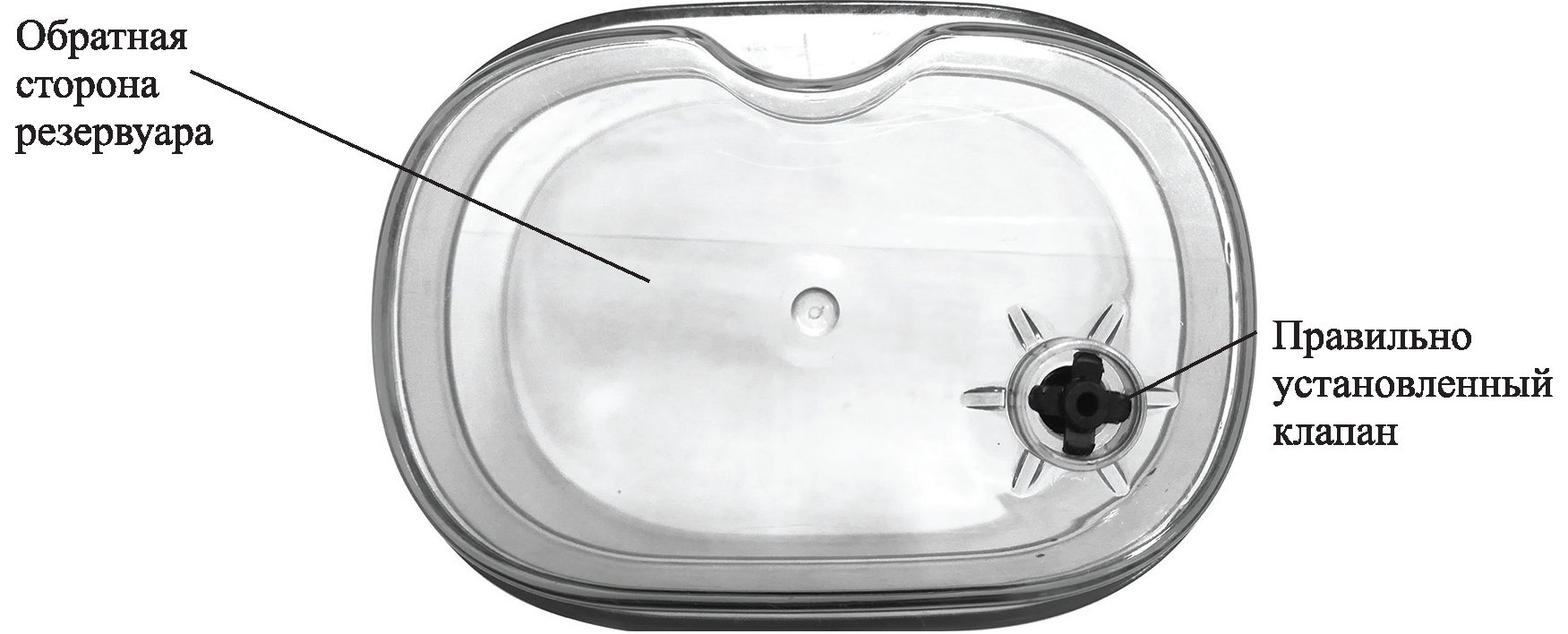
Store the device in a cool, dry place out of the reach of children. If you are not using the appliance for a long time, wash and dry all parts of the appliance. Turn the tank over and drain the water, drain the water from the recess in the body. Store the irrigator in the box.
Toothbrush cleaning
Rinse the brush every time you use the brush to remove any residual paste after brushing, then let it air dry. Do not rub the bristles to avoid damaging them.
Wipe the brush body with a soft cloth. Do not immerse the body of your toothbrush in water. Do not wash your toothbrush with water above 40 ° C or harsh detergents.














